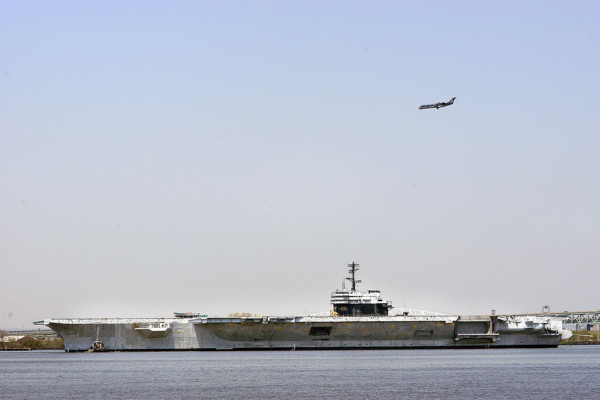The United States Navy has 11 aircraft carriers leading their respective strike groups in frontline conflicts globally, serving as a deterrent against adversaries like the Chinese Communist Party. The supercarrier fleet is renowned for its striking power, immense size, and versatile combat capabilities, with an indomitable reputation. How do American aircraft carriers manage to be nearly unsinkable? The reliability and durability of these ships can be partly attributed to the sacrifices made by their predecessor, the USS America.
The USS America, an Kitty Hawk-class aircraft carrier, served in the U.S. Navy for thirty years before deliberately being sunk in 2005 for controlled explosion research purposes instead of direct retirement. The ship gained recognition for its strong resilience during its deployments in the Vietnam War and Middle East crises. The data and findings obtained from the controlled explosion process have contributed to future aircraft carrier designs. The USS America now lies at a depth of 17,000 feet below the surface of the Atlantic Ocean, serving as a symbol of the enduring legacy of the U.S. military.
This aircraft carrier, nicknamed “Big A,” cost $400 million to construct, is over 1,000 feet long, with a flight deck area of 4 acres, capable of accommodating up to 100 aircraft. Its spacious flight deck incorporates the functionality of an angled flight deck, allowing aircraft to be launched from the bow while simultaneously enabling other aircraft to land nearby, enhancing the carrier’s efficiency. The ship is also equipped with a mirror-assisted landing system, an advanced control and landing technology composed of mirrors and lights to safely guide pilots back to the carrier deck and reduce accidents.
The USS America played a role in many significant conflicts throughout history, frequently sailing in the Mediterranean and Atlantic. During the Vietnam War, it was deployed three times in the Pacific, conducting over 10,000 flight operations with crew members dropping thousands of tons of ammunition, achieving a record of no aircraft losses.
Additionally, the carrier participated in the Gulf War, launching airstrikes against Iraq and Kuwait during Operations Desert Shield and Desert Storm. Apart from serving in global conflicts, the USS America was also responsible for transporting humanitarian aid and assisting in personnel evacuations during natural disasters and humanitarian crises.
After retiring in August 1996, nearly a decade later, the U.S. Navy decided to conduct a research project on the ship to test its ability to withstand battle damage, aiming to enhance the durability of future vessel designs. Some veterans who served on the USS America opposed seeing this legendary aircraft carrier meet such an end and advocated for its preservation as a museum.
However, then-Deputy Chief of Naval Operations for Operations and Plans, Vice Admiral John Natham, emphasized the crucial importance of the USS America aircraft carrier’s “ultimate and indispensable contribution” to the national defense. Natham, who is now retired, stated that the legacy of the USS America would serve as a footprint for future aircraft carrier designs that would protect the descendants of American veterans.
The U.S. Navy quickly realized that sinking an American aircraft carrier was easier said than done. The carrier endured both surface and underwater explosive attacks, with the latter simulating torpedo strikes in real combat situations aiming to damage the ship’s keel. The vessel was also subjected to missile and bomb attacks. The Navy monitored the damage inflicted on the ship from a distance as well as through monitoring systems installed throughout the carrier.
After four weeks of bombardment, the USS America aircraft carrier remained afloat on the high seas. According to reports from “National Interest,” sinking this carrier was described as a daunting task.
Explaining the difficulty of the operation, an expert shared with The Aviation Geek Club, “It took them four weeks, and in the end, because it wouldn’t sink, they had to scuttle her from the ship. She was not only much larger than battleships from World War II but also much more strongly built. Although she did not have the heavy armor of the older warships, her hull was double-skinned, meaning that weapons had to pass through alternating layers of steel and compartments to reach the interior. Most importantly, her internal compartments were much better than battleships. She was so large that to sink her, much more space had to be filled with water than battleships.” The expert stated.
Clearly, the ship could not be sunk in the conventional way; thus, the Navy had to place explosives on board to blow holes in its double-hull, ultimately causing it to sink on the morning of May 14, 2005, at 11:30 a.m.
The Navy has classified most of the findings from the sinking exercise as confidential, with only two photos documenting this historic moment released to the public. The fully intact ship sank to a depth of nearly 17,000 feet below the surface of the Atlantic, somewhere between South Carolina and the Bermuda Islands. This exercise marked the first and only time a modern U.S. aircraft carrier was sunk.

